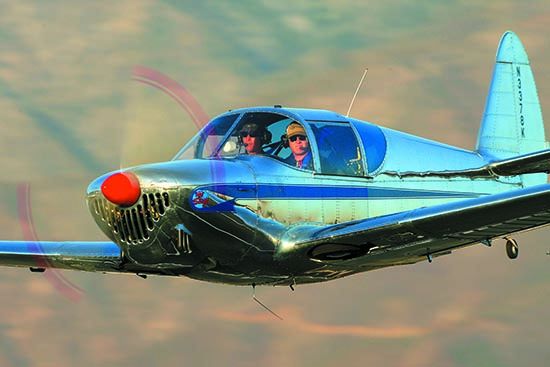You flew a Diamond DA-40 Star because it has a stick and superb handling; you took aerobatic instruction because you wanted more than just plain vanilla aviating. Now you’re thinking hard about focusing on an airplane that is outside the mainstream—vintage, antique, dedicated aerobatic machine or a warbird—but you’re unsure where to start and how far you can realistically go. Can you get insurance if you buy something that is rare? Can you find someone who can give you a solid checkout? Will you be able to find someone to maintain it? Are there parts available?
For the sake of convenience we’re going use the term “vintage” to refer to anything outside of the mainstream of nosewheel, civilian airplanes built after World War II. That includes any aircraft built before late summer 1945, all warbirds—aircraft that were used by the military (including civilian models bought off-the-shelf)—and all tailwheel aircraft. Yes, that’s a big hopper, but we’re going there because these aircraft either require more skill to operate than non-vintage machines or are more challenging to maintain or are more difficult to insure or are types the public will pay money to see on display or flying in airshows or some or all of the above.
Selecting, buying, insuring and operating vintage aircraft is just like selecting, buying, insuring and operating a 1975 Piper Archer—only more so. We’re going to go into that process, make suggestions about doing it successfully, identify some pitfalls and generally give guidance that we hope will result in you getting more smiles per dollar that you spend on a vintage flyer. After all, the reason to fly vintage airplanes is to have a lot of fun.
PAY THE DUES
However, you do have to be willing to pay some dues in terms of money, time and dedication.
We researched this article from the perspective of someone who decides to get into the vintage world and go as far as he or she possibly can—wishing to own and fly a seriously valuable antique such as a Beech Staggerwing and display it at airshows both on static display and in flybys; or own and operate what had been a serious warbird, whether trainer or combat machine, and put it through its paces at airshows; and/or buy a dedicated aerobatic airplane such as a CAP-10 and perform at airshows.
After speaking with pilots who own vintage airplanes and do everything from happily flying them over the countryside with friends to doing aerobatic routines at airshows, we came away with some recommendations that were common to every airplane in our self-declared vintage class.
First, knowledge is power. There are no shortcuts to moving up to more complicated airplanes and challenging ways of flying them.
Second, you will be able to find experts who will be willing to help you if you are willing to listen with an air of humility.
GETTING STARTED
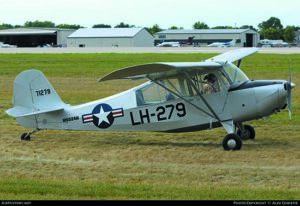
Step one in the process of owning and flying vintage, according to Stan Musick, longtime warbird owner, airshow performer and former chief check airman for fighters for the Commemorative Air Force, is deciding what you want and the resources you have to support the aircraft. “You’ll want to pick an airplane that you’re passionate about, otherwise you’re going to get tired spending lots of money on it and the effort it takes to get it in and out of the hangar.”
The big break point items are whether you want to go tailwheel or nosewheel as we’ll as tube-and-fabric or metal airframe. Going tailwheel generally means that you are going to have to get at least 200 hours of tailwheel time before you are going to be able to get insurance in anything that has more than two seats or is worth more than $100,000.
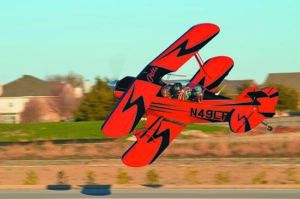
When it comes to insurability in any airplane, especially one with a tailwheel or high worth, it’s all about experience and age, according to Scott “Sky” Smith, an insurance broker with some 40 years of experience placing insurance in all types of aircraft.
AGE
We’ll get through the age part right now: If you haven’t moved up into the airplane you really want to fly—and have insurance on it—by the time you are 69 years old, you are unlikely to be able to do so. Having cubic money no longer means that you can buy insurance in anything at any age.
That should be kept in mind as we were told by the pilots we interviewed that it is potentially a 20-year process of moving up the pyramid in the vintage world to ownership and doing airshows in the very best of the airplanes: P-51s, Waco Taperwings and Extra 300s.
The path is not as long if you go the nosewheel route. That is simply because pilots flying tailwheel airplanes—no matter how good those pilots are—are two to three times more likely to tear up the airplanes in landing accidents.
If you start out in the tailwheel world, it’s fairly easy to switch to nosewheel—not the other way around. If you start in the tube-and-fabric world, it’s relatively easy to switch to metal aircraft.
In speaking with Stan Musick and Patty Wagstaff, former national aerobatic champion, we were told that for someone desiring to go the tailwheel route, the best thing to do is buy an Aeronca Champ and fly it 200 hours in the first year. Wagstaff also spoke highly of the American Champion Citabria and Decathlon for building initial tailwheel experience.
Musick emphasized that flying that much in a year means that the pilot is going to get real-world experience with weather and things breaking—she or he isn’t going to just do the same hour 200 times. Plus, the pilot is going to learn what adverse aileron yaw is and what the rudder pedals are for.
Doug Rozendaal, longtime warbird owner and designated examiner, echoed the sentiment go get started with a Champ. “It’s cheaper than a Cub, flies nicer and you can do an annual for $500 if you are supervised by an IA.”
As Stan Musick put it, “Once you own the airplane and have insured it, only the first hour is expensive, after that it’s just gas and oil.”
Pilots we spoke with while researching this article also spoke highly of building time in a Luscombe, especially if your goal is owning an all-metal vintage airplane.
Experienced tailwheel instructors Derek DeRuiter, proprietor of Northwoods Aviation in Cadillac, Michigan, and Paul Berge of Indianola, Iowa, spoke highly of obtaining significant tailwheel experience in an airplane with heel brakes, rather than toe brakes. Heel brakes are more challenging to use and usually less effective than toe brakes, so a pilot learns to solve takeoff and landing problems with the flight controls and not use the brakes as a crutch.
DO YOUR HOMEWORK
All of the pilots we interviewed said that learning as much about the airplane you seek to buy is essential. They recommended joining the type club as most have significant online libraries as we’ll as members with expertise.
Join the Experimental Aircraft Association (www.eaa.org). Your local EAA chapter can be a wealth of information as members don’t just own homebuilts, they own vintage machines or will know people in the area who do.
Doing your homework will let you learn what to watch for on a prebuy examination of an airplane that has grabbed your interest as we’ll as find an A&P who has expertise in the type to do the prebuy.
PREBUY EXAM
By the way, when it comes time for the prebuy exam of the vintage airplane you’ve chosen we think that you treat any claim that it has “no damage history” as nonsense. If it’s an old airplane, particularly if it has a tailwheel, it’s almost certainly been damaged at some point—even if it’s not reflected in the logbooks or Form 337s.
The task for you and your A&P during the prebuy is to make sure that if repairs have been done on the airplane at some time in the past that they were performed correctly. Six months after you buy the airplane you don’t want to be tearing into a wing to fix a poorly done repair job that is coming apart.
RESOURCES NEEDED
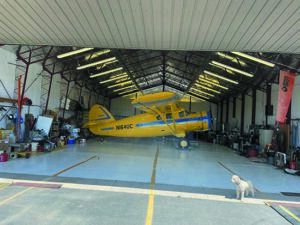
Meeting owners and spending some time with their airplanes will also give you a feeling for the maintenance demands of the type—and whether there are resources in your area that will allow you to maintain what you buy. If you’re going tube and fabric, is there someone who can fix yours when something breaks or you damage it on landing?
Are their flight instructors in your area that are qualified and experienced in the airplane you want? Increasingly we’re hearing that owners of vintage airplanes, particularly smaller ones, cannot find qualified CFIs.
Getting to know owners may also mean that you get a chance to fly examples of the type—and you may discover that you don’t like it. A high-time tailwheel pilot friend who decided that he wanted a WWII Feissler Storch (STOL, German two-place liaison airplane) bought one without having any experience in the type. On the ferry flight home he discovered that he hated the thing and decided to sell it right away. Not surprisingly, he took a financial hit.
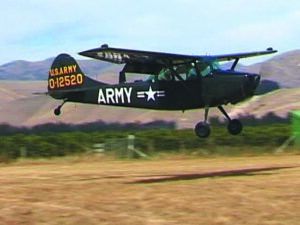
The other benefit of flying before buying was pointed out to us by aviation insurance broker Mike Pratt of Louisville, Kentucky—you are much more insurable and your initial premium will probably be less if you have at least a couple of hours in type so that you don’t have to put zero in the time in type column on the insurance application.
In speaking with Scott “Sky” Smith and Mike Pratt we were surprised to hear that not all pilots have gotten the message about making sure that they can get insurance before buying an airplane. Each told us that once or twice a year a potential client calls up saying that he’d just bought a new airplane, wanted insurance and then the broker couldn’t find an insurance company that would insure that pilot in that airplane.
INITIAL EXPERIENCE
After you’ve done your homework on your first vintage airplane and your due diligence before the purchase—title search, FAA file, prebuy exam—it’s time to get to know your airplane well.
Take dual with an instructor who knows the type—your insurance will probably require it—and start learning the features and quirks of your new airplane. Vintage airplanes are known for having screwy, non-intuitive systems, particularly fuel systems. For example, an Aeronca Chief has an aux fuel tank behind the cabin that gravity feeds the main tank in front of the cabin and requires positioning the fuel selector correctly in the air and on the ground to avoid dumping fuel overboard.
Then, go fly. A lot. We weren’t kidding about 200 hours the first year. Learn to handle crosswinds and write down your personal limits for them. Learn how much runway the airplane really needs, especially on grass and on hot days. Toss a sleeping bag in back and just go. Get away from your local area and learn all you can about different airports and conditions. That’s what makes a stick-and-rudder expert, which is what you want to be if you want to fly funky, vintage airplanes.
SWING A WRENCH
Learn to do all of the owner-approved maintenance under the FARs and, if possible, spend time working under the supervision of an A&P so that you truly know the private parts of your airplane and what tools you should carry. If nothing else, flying vintage means you’re going to have to know which wrench to swing when something goes wrong—which it will—on that deserted, beautiful grass strip miles from anywhere.
If your goal is tube and fabric, learn to make repairs. Better yet, get involved with covering an airplane—your EAA chapter will probably know someone who needs help and would appreciate your assistance.
Get to know the airplane cold. If the engine quits at 500 feet at Vy, what is your real radius of action? If it quits at 3,000 feet, make sure that you can spiral down and land on a 1500-foot-long clearing surrounded by trees.
If there is an air museum or organization that operates the sort of vintage aircraft you want to fly, join the organization as a volunteer—while planning to work hard. It gives you a chance to learn more about the aircraft as you are building the time and experience you’ll need to be considered by the group to fly the airplane.
The downside is that there are always politics in human organizations and you may find that you don’t fit in with the organization or that it has a safety culture that you are uncomfortable with. Patience often pays off—you’re in this for the long haul—and you may come to be in a position where you can make positive changes.
Fly with others who have the same type or similar airplanes. Get to know who you are willing to fly with—and who it’s wise to stay away from.
Part of the fun of owning vintage is not only socializing with like-minded pilots, it’s flying the airplanes together.
MOVING UP
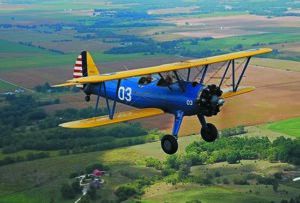
According to the pilots and insurance brokers we spoke with, once a pilot has at least 200 hours of tailwheel time and 500 hours total time, it’s OK to scratch the itch to move up in the vintage world. While scores of pilots find that the “starter” airplanes—Champs, Cubs, Luscombes, Cessna 120s/140s—are ideal for them for the long run, many salivate over more power, greater size, more speed and more capability.
In the tailwheel world we learned that stepping up to more power—generally 300 HP or less—and up to six-place is going to be something that a pilot with 200 hours of tailwheel time is going to be able to do with a solid checkout. And that checkout should be with an instructor with time in type. The Globe Swift may be a two-place airplane with modest horsepower (unmodified), but it has its own set of handling demands and non-intuitive systems that will bring someone attempting to fly it cold to grief. “Oh, that’s the flap switch.”
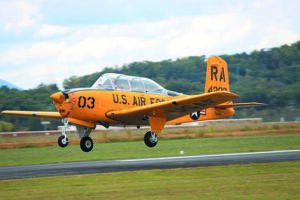
If it’s a two-place World War II trainer that elicits airplane lust, your 200 hours in a Champ will go a long way toward easing your transition. For some, you’ll be learning the care and feeding of a new engine, but the stick and rudder skills that you’ve polished will probably mean that you won’t embarrass yourself during the checkout.
Oh, as Doug Rozendaal told us, “It’s getting tougher to find CFIs to teach in Champs, but once you move into cooler airplanes such as the Boeing Stearman, or the larger warbirds and antiques, it’s a lot easier finding people who will help you, including CFIs. They want to be around those airplanes.”
At this level in vintage flying, you’re going to have an airplane that will attract attention wherever you go and may be appropriate for static display and fly-bys at fly-ins and airshows, so you’re going to be increasing your circle of people who can help you learn about your new airplane, the display flying world and the next steps you want to take in the vintage world.
AIR MUSEUM
If you are tied in with an air museum or vintage organization, your Bird Dog or Fairchild 24 may be something they’ll want to display and your experience in it can help you if you want to fly the more sophisticated aircraft in the museum’s collection.
This is a good place to again discuss the resources available to you at your home base as you make the decision to move up to larger vintage airplanes. A Bird Dog is about the largest of the warbirds that you can count on being able to get in and out of your hangar without help or a tug. Will having to rely on a tug or help mean that you won’t fly your airplane as much as you otherwise would? This is about having fun.
We think of our friend Dr. Brent Blue who has to put his Noorduyn Norseman into his hangar sideways using a tug and a sophisticated set of dollies. He’s happy with it.
Is there someone who can work on radial engines, if you go that route? Are you still in shape enough to do the climbing necessary to do a preflight on some of the big vintage airplanes?
Open-cockpit airplanes create their own challenges. Are you willing to fly a Boeing Stearman in the winter where you live? Will you fly the airplane enough to keep it from that aircraft maintenance villain—not flying and developing corrosion?
WARBIRD STEP-UP
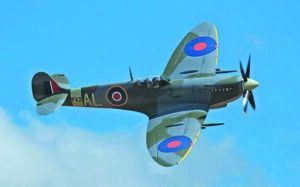
If you want to take the next step in warbirds, the North American AT-6/SNJ/Harvard has become the coin of the realm. It is challenging to fly and has unconventional systems and egregious stall behavior—which has killed a lot of pilots. However, it is hugely fun to fly, does decent aerobatics, the 600-HP Pratt up front is one of the best engines ever built and it is the trainer that must be mastered before flying any of the tailwheel, piston-engine fighters.
Plan on getting 200 hours in an AT-6, including about 60 in the blind rear seat, before any of the museums will let you step into one of their fighters or you can get insurance if you buy a fighter.
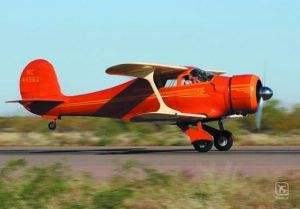
If you have the financial wherewithal to buy a WWII fighter there are two things we learned while doing our homework: One, they have been solidly holding their value at the least. We liked Doug Rozendaal’s comment: “They are a place to store cash because they don’t go down in value. Insurance, fuel and maintenance is the cost of ownership.”
Two—and we hear examples of this every year—wealthy individuals who are not used to hearing the word “no” and are devoid of humility who buy a fighter rapidly find that those who are capable of checking them out are never available. In the past, that meant that they flew their machines anyway, and usually wrecked them fairly early on. Now, with tough checkout requirements to get insurance those owners tend to give up and sell their airplanes.
Finally, a nod to the nosewheel vintage airplanes. You don’t have to get 200 hours of tailwheel time. What you will need is the level of experience and hours appropriate for a spam can airplane. A Navion is a warbird; it’s also a civilian airplane that has retractable gear and a constant speed prop. Figure on a couple of hundred hours total time and a 10- to 25-hour checkout depending on your retract time.
One of the most delightful flying of the warbird trainers is the Beech T-34 Mentor. It’s a modified Bonanza—total time and retract time requirements to get insurance in a Bonanza should be the same for the T-34—along with a checkout to get used to the type.
In the multi-engine world, most of the opportunities to fly warbirds are through the museums, and you are going to have to have substantial multi-engine time in “heavies.” For years, the Beech-18 freight dogs ruled supreme flying the C-47s, B-25s and B-17s of the museum world. It’s still mostly professional pilots who have a great deal of multi-engine time, so it’s tougher for the person coming up as a nonprofessional pilot—yet we’ve seen it done.
CONCLUSION
We’ll wrap up with another warning to be extremely careful when buying vintage—because some of the airplanes are so expensive, there are plenty of people out there who will happily take your money and not provide a service that you need. We like Stan Musick’s advice: Don’t seek information from someone trying to sell you something.
Do your homework before buying, have a prebuy done by an A&P who knows the type well, assume there is damage history and approach flying the airplane with a great deal of humility. They are treasures, the pilot may not be.

